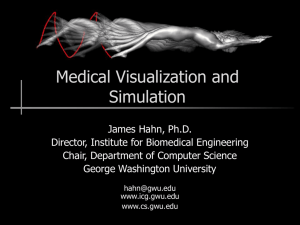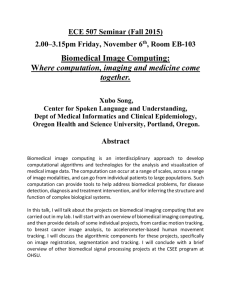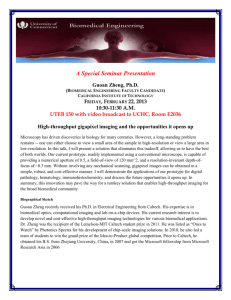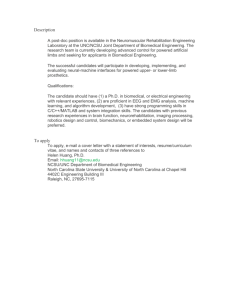Biomedical Engineering areas - Department of Electronic and
advertisement
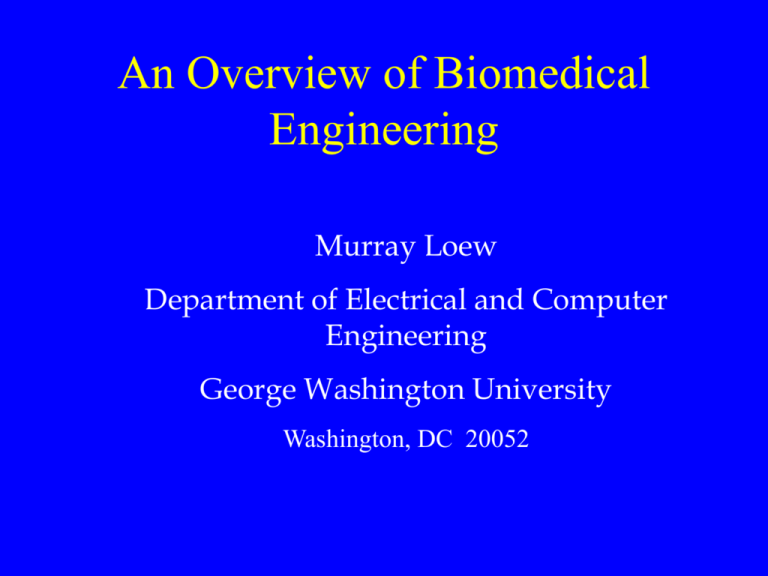
An Overview of Biomedical Engineering Murray Loew Department of Electrical and Computer Engineering George Washington University Washington, DC 20052 Biomedical Engineering • Who? – GW faculty, GW students • What? – Applying engineering to health care • Why? – Curiosity, satisfaction, contribution, jobs • How? – Research, design, clinical Who • Zhenyu Guo Murray Loew Department of Electrical and Computer Engineering What • • • • • • • • Bioinstrumentation Biomaterials Biomechanics Biomedical computing & signal processing Biomolecular engineering MEMS Minimally invasive surgery Tissue engineering, ... Major advances • • • • • • • Hip joint replacement • Heart pacemaker Magnetic resonance imaging Arthroscopy • Heart-lung machine Angioplasty • Bioengineered skin Timed-release drug capsules Artificial articulated joint Kidney dialysis Bioinstrumentation • The application of electronics and measurement principles to develop devices used in diagnosis and treatment of disease. • EXAMPLES are the electrocardiogram, cardiac pacemaker, blood pressure measurement, hemoglobin oxygen saturation, kidney dialysis, and ventilators. Biomaterials • Describes both living tissue and materials used for implantation. • Choose appropriate material • Nontoxic, noncarcinogenic, chemically inert, stable, and mechanically strong enough to withstand the repeated forces of a lifetime. • Metal alloys, ceramics, polymers, and composites Biomechanics • Mechanics applied to biological or medical problems • Study of motion, material deformation, flow within the body and in devices, and transport of chemicals across biological and synthetic media and membranes. • EXAMPLES: artificial heart and replacement heart valves, the artificial kidney, the artificial hip, function of organs Biomedical computing & signal processing • Computers are becoming increasingly important in medical signal processing, from the microprocessor used to do a variety of small tasks in a single-purpose instrument to the extensive computing power needed to process the large amount of information in a medical imaging system. Segmentation and labeling of electron microscope images at GWU Micro-electromechanical systems (MEMS) • Microtechology and micro scale phenomena is an emerging area of research in biomedical engineering • Many of life's fundamental processes take place on the micro scale • We can engineer systems at the cellular scale to provide new tools for the study of biological processes and miniaturization of many devices, instruments and processes MIT Minimally invasive medicine & surgery • Uses technology to reduce the debilitating nature of some medical treatments. • Minimally invasive surgery using advanced imaging techniques that precisely locate and diagnose problems • Virtual reality systems that immerse clinicians directly into the procedure reduce the invasiveness of surgical interventions. GWU Robarts Research Institute, U. of Western Ontario Rehabilitation engineering • A new and growing specialty area of biomedical engineering • Rehabilitation engineers expand capabilities and improve the quality of life for individuals with physical impairments. • Because the products of their labor are often individualized, the engineer often works directly with the disabled individual Biosensors and electrodes • Sense signals within the body as required for diagnosis • These are used to measure the signals from the heart (electrocardiogram), lung (spirometer), blood (glucose sensor), vessels (blood flow) and body (temperature) Telemedicine • • • • Delivering health care at a distance Diagnosis Therapy Real-time consultation Tissue engineering • The principles of engineering and life sciences are applied toward the generation of biological substitutes aimed at the creation, preservation or restoration of lost organ function. This field is dedicated to the creation of new functional tissue Biomedical Engineering Research at GW • Elastography for breast cancer diagnosis • Doppler signal processing in carotid plaque detection • Multimodality medical image registration • Task-based quality measurement of compressed medical images • Impedance imaging sensor development • Tissue characterization using fluorescencelifetime imaging Recent Accomplishments at GWU Portable Doppler device Catheterization simulation New techniques for breast cancer diagnosis 3D ultrasound imaging Multimodality medical image registration Why? • • • • challenge interdisciplinary results are visible and beneficial many kinds of jobs available The new GWU program • New BME B.S. program coming in Fall '02! (pending Board of Trustees approval) • Real experience at NIH, NRL, TIGR, ... • Five areas of concentration: bioinformatics, telemedicine, instrumentation, premed, biomechanics Curriculum • 4 years • 2 required summer experiences • lab experience starting in freshman year, mentored by upperclassmen • junior/senior design project • interdisciplinary with Medical School, Science, and GW Hospital Curriculum – Specialty Labs • • • • • • bioinformatics and computational modeling imaging and telemedicine telemedicine and instrumentation biotechnology, nanotechnology, and MEMS visualization and simulation movement and injury sciences Call, write or visit: • (202) 994-7180 • (loew, zguo) @ seas.gwu.edu • Biomedical Engineering Program, Department of ECE, George Washington University, Washington, DC 20052 Extending the reach of Biomedical Engineering at GWU
